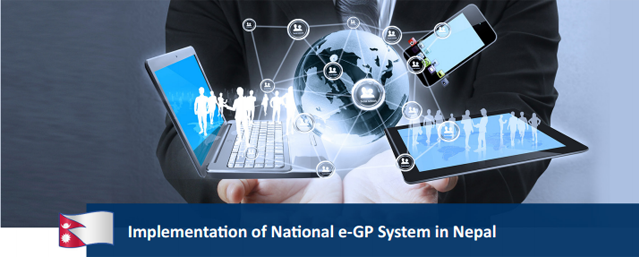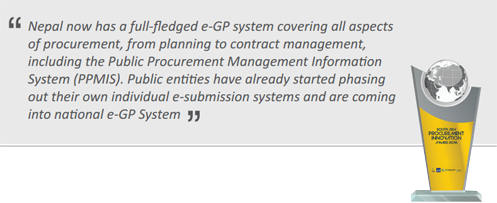Feature Stories
- How Bangladesh bridged the gap between amateur and professional in government procurement
- Rated Criteria: Promoting Value in World Bank Procurement
- Public Procurement Transformation in Bangladesh
- Achievement of Value for Money and Enhancement of Efficiency, Economy and Transparency in Procurement - Document Archive System
Archives
- End-to-End Procurement Planning and Maintenance System Integrated with Project MIS
- Application of Construction Milestones in Rural Road Contracts of Nepal
- Gross National Happiness Model for Pursuing Sustainable Public Procurement
- Government procurement is the basis of wide opportunities for enterprise development
- The Challenges of Procurement Training in a Fragile Country: the Afghanistan Experience
- When and How to Open Contracts: Transparency and Engagement through World Bank Projects
- Innovations and Best Practices in Procurement Processes of Disaster Recovery Projects
- World Bank Experts Discuss Global Procurement Trends and Armenia's e-GP system with the National Assembly
- Technology driving transparent and accountable public procurement reform in Bangladesh
- Prototype for Implementation of Framework Agreement via Blockchain
- Construction Project Planning and Management Capacity Building in India: A Wholistic Approach to Boost Infrastructure Development
- Zimbabwe: Public Procurement reform to catalyze greater transparency and development
- 15th Procurement, Integrity, Management and Openness (PRIMO) Forum
- e-Procurement World Map
- Preventing and controlling corruption: A modern approach to Procurement
- 6th South Asia Public Procurement Conference held in Thimphu, Bhutan
- South Asia Procurement Innovation Awards 2018 Announced
- Procurement iNET completes 5 years and new CPPP Fastest 100% Challenge Launched
- Risky Business: Does Debarring Poor Performers Mitigate Future Performance Risk?
- Global Procurement Summit 2019, New Delhi, India
- World Bank India launches Survey for International Civil Works Contractors
- World Bank launches new Complaints Module in Systematic Tracking of Exchanges in Procurement (STEP) System
- New Open Contracting Data Standard for e-Procurement Systems Launched
- Bangladesh's success in public procurement: Sustained reform really pays off
- The five drivers for improving public sector performance: Lessons from the new World Bank Global Report
- South Asia Public Procurement Innovation Awards 2018
- Conversation with Khaled Elarbi, President, High Authority for Public Procurement (HAICOP), Tunisia on the Digitalization of Public Procurement
- Breaking the glass ceiling in Africa: Rwanda E-Government Procurement System
- How government e-marketplace is revolutionizing procurement in India
- Ensuring Value for Money in Infrastructure Projects - The Botswana way
- Blockchain Lessons for Procurement
- Botswana’s Benevolent Move to Enhance its Procurement Profession
- Achieving Better Value for Money Using e-Auction for Procurement of Goods by Public Sector - A Success Case from DPDC
- Guide to Project Management and Contract Management (GPMCM) – New Approach to Improve Efficiency and Effectiveness of Procurement Outcomes
- Regional Winners of SAPIA 2017 participate in 8th International Public Procurement Conference (IPPC 8) Arusha, Tanzania
- The Future of Public Procurement in the Era of Digitalization
- World Bank Operations Procurement Helping Turkey to Procure a US$2 Billion Gas Storage Facility
- Unlocking Energy Efficiency Market in India - Through Innovative Procurement Business Model
- Getting value for money: Creating an automated market place for farmers in Pakistan
- Towards a Single Market for Public Procurement in Caribbean Small States
- Web-Based Online Evaluation Tool (e-Tool) for Procurement of Works by Royal Government of Bhutan
- Strengthening Health Sector Procurement System Offer Hopes for Universal Health Coverage in Nepal
- Morocco makes Strides in Modernizing its Public Procurement System— Operationalization of the Procurement Regulatory Body
- Innovations in Procurement Process and Selection that Lead to Improved Outcomes – Tenderers’ Database Management System
- Looking Back and Forward: The World Bank’s Procurement Framework
- Independent Monitoring and Evaluation of Contracted Health Services Leads to Improved Outcomes in Rural Areas of Afghanistan
- Fifth South Asia Region Public Procurement Conference brings focus on Procurement in Public Service Delivery
- 12 Procurement Innovations from South Asian Countries Celebrated
- Social Media is Improving Procurement in Lao PDR
- ASEAN meeting explores ways of professionalizing public procurement to meet development challenges
- Second International Training Program on the World Bank’s New Procurement Framework
- South Asia Procurement Innovations Award 2017 launched with Bigger and Better Prizes
- How to bid, finding opportunities, what makes a successful bid
- Pushing boundaries in procurement framework implementation
- Experience of Developing PPSD for the Assam Agribusiness and Rural Transformation Project (APART), India
- An Electronic Approach: Streamlining Georgia's Procurement
- South Asia Heads of Procurement Knowledge Exchange Program to U.S. Government Procurement Systems started
- 13th Procurement, Integrity, Management and Openness (PRIMO) Forum - a Documentary
- Bangladesh to strengthen public procurement with World Bank supported Project
- Establishment of Technology-Based Health Procurement and Supply Chain Management System, and Capacity Development in Tamil Nadu Medical Services Corporation
- Towards a Single Market for Public Procurement in Caribbean Small States
- Redefining Procurement as an Innovative and Collaborative Centre of Excellence for Best-in-Class Sourcing Solution
- India’s PowerGrid Endorsed for Alternative Procurement Arrangements by the World Bank
- Achieving Value for Money in Indonesia’s Geothermal Project
- Citizen Monitoring of Rural Roads Under Pradhan Mantri Gram Sadak Yojana (PMGSY), India
- Establishment of Grant and Service Contract Management Unit (GCMU) to Manage Contracting Out of Health Services in Afghanistan
- Procurement for Regional Development–Public Policy Initiative in Sri Lanka
- PPAF Community-Driven Development (CDD) Procurement Model, Pakistan
- Making Successful Procurement of IT Systems - An Experience from Vietnam
- Procurement Observatories continue to deliver in India
- Implementation of National e-GP System in Nepal
- Government e-Marketplace (GeM), India
- Africa High Level Public Procurement and Electronic Government Procurement Forums
- Development of Procurement Cadre as Part of Holistic Procurement Reforms in Bhutan
- Modernizing Public Procurement in Zimbabwe, one Step at a Time
- Citizen Engagement During Public Procurement Implementation in Bangladesh
- Winter 2017 Virtual Procurement, Integrity, Management, and Openness (PRIMO) Forum on Sanctions and Debarment Systems
- Close and Personalized Procurement Monitoring, Leading to Procurement Efficiency in Irrigation Sector in Fragile and Challenging Environments of Afghanistan
- Procurement Framework 2016 offers wider choices to ‘Go to Market’ based on PPSD
- Procurement Framework 2016 - Benefits, Status of Roll-out and M&E Arrangements
- PPSD offers Fit for Purpose Procurement Solutions
- Global Procurement Summit
- Fourth South Asia Region Public Procurement Conference
- The World Bank e-Procurement Tools
- South Asia Procurement Innovations Awards, 2016
- Learning Videos launched on STEP, online tracking tool on procurement for World Bank Projects
- Open e-Learning is Building a Cadre of Procurement Experts
- South Asia Region Public Procurement Conference, 2017
- Online Certificate Program in Public Procurement in Arabic Launched in Egypt
- First Procurement Knowledge Exchange Forum among ASEAN Countries
- Nobel Prize in Economics for contribution to Theory of Contract
- The Africa Region Harnesses Integrated e-Government Procurement (e-GP) Systems in Pursuit of Transparency and Integrity
- Procurement Reform for Humanitarian and Development Challenges in Kurdistan Region of Iraq (KRI)
- Successful Procurement is not just a set of Activities, it is a Strategy
- Afghanistan - Trends and Recent Developments in Governance
- PPSD is an Opportunity for clients and staff for Improved Procurement Management
- Procurement Reform Advances in the MENA Region
- Data Analysis and Collaborative Work in Action for Expedited Disbursements in Africa
- Ensuring Good Governance in Procurement in Sri Lanka
- New Procurement System to Improve Development Impact and Transparency in South Asia
- World Bank, USTDA Formalize Procurement Partnership
- How the New Procurement Framework Will Benefit 45.6 Million People in India
- Procuring the Future
- Reasons to Bid, Finding Business Opportunities
- New World Bank Procurement Framework Promotes Strengthened National Procurement Systems
- The readiness for Procurement Framework 2016
- 6 Things to know about New Procurement Framework
Implementation of National e-GP System in Nepal


{This article is an abridged version of the submission on “National E-GP System Implementation in Nepal” made by Mr. Ramesh Kumar Sharma, Secretary, Public Procurement Monitoring Office, Kathmandu, Nepal, for the South Asia Procurement Innovation Awards.}
Summary
e-Government Procurement (e-GP) initiation in Nepal was started by a comprehensive study “Electronic Government in Nepal” carried out in December 2003. Several building blocks for implementation of e-GP in Nepal were already in place. Internet connectivity was available in almost all government administrative premises up to the local level. There were also a significant number of Rural Community Centers, Cyber Cafes, and Business Centers with ICT facilities across the country. An e-GP Readiness Assessment conducted in 2007 established that the level of readiness for e-GP in Nepal was reasonable. The only major problem was lack of an appropriate lead agency to drive and sponsor the electronic procurement reform.
Background
Government of Nepal formed the Public Procurement Monitoring Office (PPMO) as the Regulatory Authority for Public Procurement to develop and operate the national e-Government Procurement (e-GP) system in the country. PPMO is strongly fulfilling its mandate of governing the Public Procurement sector in Nepal, including introduction of a unitary National e-GP System. Every public entity should mandatorily use the national e-GP system for its procurement above {NPR 6 million (USD 60,000 (1 NPR = 0.0093 USD)). Thus, all public entities receiving funds from the Government of Nepal are in the scope of the e-GP system.
In 2010, PPMO prepared the Nepal Public Procurement Strategic Framework (NPPSF) Phase I (2010-2013). Its Phase II (2013-2016) adopted a strategic policy for implementation of national electronic-Government Procurement (e-GP) system, instead of using individual e-submission systems. In the journey of PPMO to streamline public procurement proceedings and modernize the procurement activities through electronic means, Asian Development Bank (ADB) and World Bank (WB) too provided their support to PPMO. World Bank and Asian Development Bank have already assessed the system and have committed to use the national e-GP system for their funded projects.

Lack of transparency in government procurement has been a systemic problem in Nepal. In addition, inefficiency due to manual and paper-driven procurement processes has resulted in poor service and limited participation of bidders. The 2003 study under Electronic Government in Nepal found that establishing an e-GP System could help improve transparency, efficiency, and value for money in government procurement. Stakeholders (government agencies and suppliers) also showed their support to the e-GP concept.

A strong commitment at the highest political level, reflected through an amendment to Procurement reforms and a demand-driven process, with extensive consultations involving all stakeholders at the time of developing the e-Procurement solution, make e-GP innovative in Nepal’s economic and political context. In 2011, through the third amendment to the PPR (Public Procurement Reform), PPMO was mandated to operate a single national e-GP portal. The amendment also clearly stated that public entities should carry out their procurement transactions through the single e-GP Portal established by PPMO. Thus, developing and implementing the e-GP system became national agenda.
PPMO conducted a study to envisage the functionality of national e-GP system and make it compatible with international e-GP best practices. As per the study’s recommendation, a national e-GP system was developed in two phases – Phase I and Phase II. e-GP Phase II is the upgraded version of e-GP Phase I. e-GP Phase I covers up to only bid opening and e-GP Phase II covers all the functions after bid opening i.e. bid evaluation, contract awarding, contract management, dispute management, and payment. At the moment, Government of Nepal and its various entities are using Phase I and Phase II parallelly.

Impact Generated
Since the market demand of e-GP was already high, and national-level effort on e-GP implementation was much delayed, different government organizations had started developing and implementing some form of their own e-GP functionalities. At that time, Nepal did not also have any e-GP Policy in place for implementation of a unitary e-GP system for the Government.
Now, PPMO is ready with the latest system from January 2017 for all public entities across the country, including all local-level agencies. This system is the full-fledged e-GP system covering all aspects of procurement, from planning to contract management, including the Public Procurement Management Information System (PPMIS). All Standard Bidding Documents (SBDs) of procurement of works, goods, and consulting services issued by PPMO and Single Stage Two Envelope system are integrated in the application. Public entities have already started phasing out their own individual e-submission systems and are coming into national e-GP System.

Scalability and Sustainability
e-GP Phase II caters to all the functionalities of public procurement. The system is developed based on scalable architecture and international best practices, so that it can be integrated with other ICT systems. There is no need to install, manage, and operate the system in each public entity; they just have to register into the system and use it as per their need.

The separate development of e-Submission System within individual departments / public entities has the following shortcomings:
- The separate development of e-Submission System within individual departments / public entities has the following shortcomings:
- Difficult to control and check the compliance with legal framework.
- Fragments the opportunities to bidders.
- Government’s public procurement information is scattered.
These shortcomings, in turn, impact the development of an efficient and effective high quality management framework for public sector procurement
